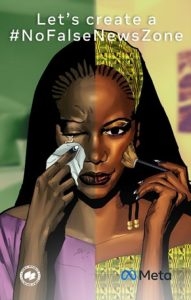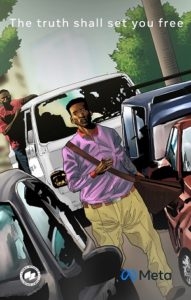Exclusive Interview With Oluwasola Obagbemi, Corporate Communications Manager, Anglophone West Africa, Meta
Oluwasola Obagbemi talked about why the #NoFalseNewsZone campaign is needed, what reliable information is, how to determine lies, and how to solve problems with the spread of fake news.
1. Why do you need to conduct a #NoFalseNewsZone campaign now?
The #NoFalseNewsZone campaign is an educational media and consumer campaign aimed at opening a dialogue surrounding false news, helping people learn how to identify it, and the actions they can take to help minimise its spread. Having realised that false information spreads fast and can also lead to real life harm, Meta decided to create the #NoFalseNewsZone online campaign to educate people on how to critically think about the messages they consume and create online. In line with this, we have also launched the #NoFalseNewsZone comic book to also deepen the awareness on reducing the spread of misinformation.
2. What events should be within the #NoFalseNewsZone campaign?
 For this campaign, we considered the touch points where we can meet and reach Ghanaians on a large scale. We also explored how to seed this all-important conversation to the heart of the average Ghanaian in an interesting, engaging and educative way. This is why we:
For this campaign, we considered the touch points where we can meet and reach Ghanaians on a large scale. We also explored how to seed this all-important conversation to the heart of the average Ghanaian in an interesting, engaging and educative way. This is why we:
- Created the #NoFalseNewsZone comic book (available for download online for FREE via https://tinyurl.com/23fme5mj)
- Printed out copies of the comic book to share with people.
- We also have a drama series playing across several radio platforms which is actually a story that was taken from the comic book and adapted to a radio drama (spoken in Twi) so people can easily understand the story and engage with it. It is the story of Nurse Akosua who almost lost her husband due to false news he believed online. In the story, you’ll learn how she and her husband overcame false news and how she teaches her patients to think critically about what they read, trust and share.
- We have radio jingles in Twi, Fante and other local languages also passing the message across to everyone
- We have adverts on TV playing so people can know how to identify false news and how to report it
- Collaboration with social media influencers to share content (Infographics, videos, skits etc) on social media so people online are not left out
We basically took a 360 degree approach to ensure that the #NoFalseNewsZone conversation reaches everyone in Ghana because everyone has a significant part to play in the reduction of false news in our community. These different activities will teach useful skills on how to identify and report false news in a way everyone can understand.
 3. What needs to be changed so that people begin to think critically? Do you agree that this needs to be taught in schools and universities?
3. What needs to be changed so that people begin to think critically? Do you agree that this needs to be taught in schools and universities?
We believe that people need to be more aware about how and where they consume information and It’s pretty easy to be a part of the millions of people that are, on a daily basis, joining the fight against false news so we can all work towards creating a #NoFalseNewsZone online. All you need to do is take a minute to do four things everytime you see something on online that looks good enough to share with your friends and family:
- Look up the source to check if it’s credible
- Check the dates: Reposting old news stories doesn’t mean they are relevant to current events
- Read the whole article, not just the headline
- Consider if your own beliefs or concerns might affect your judgement. If you’re not sure of the authenticity of the news source, DO NOT share the post. If you spot false news online, REPORT IT to Facebook and Instagram.
Individuals can use these tips to report posts anonymously and confidentially to Facebook and Instagram.
Also, we are extending this campaign to schools, universities and the community at large, just to ensure that everyone both old and young are involved in the fight against misinformation.
 4. What does it mean by reliable information?
4. What does it mean by reliable information?
We live in an age where there is a constant dissemination of information, however some of this information shared is not reliable. So, what makes an information reliable is the fact that the information must be accurate, verifiable, and from a trusted source. With our #NoFalseNewsZone campaign, we are encouraging people to look out for trusted sources, get the whole story not just the headline, and check for personal beliefs and biases before sharing any information.
5. How do you know information is reliable?
As we work to limit the spread of false news online, there are some key pointers that show that a piece of information is credible. A reliable information will be verifiable and often, stories that are reliable also sound believable. In addition, information that is reliable is often written by credible organisations that do not use catchy headlines, manipulated video or images. We encourage people to rely on such credible organisations for information and also make the extra effort of verifying information before sharing with friends and family.
6. How to recognize information lies?
False news stories often contain images or videos that have been manipulated, or wrongly attributed. Media, including image, audio or video, can be edited in a variety of ways. In many cases, these changes are benign, such as a filter effect on a photo. In other cases, the manipulation isn’t apparent and could mislead, particularly in the case of video content. To recognise falsified or misleading information, images or videos, users should inspect the dates, as false news stories may contain timelines that make no sense, or event dates that have been altered. Sometimes the photo may be authentic, but taken out of context. You can search for the photo or image to verify where it came from.
We aim to remove this category of manipulated media when it contravenes our laid out criteria. In addition, we will continue to invest in partnerships (with journalists, academics and independent fact-checkers) to help us reduce the distribution of false news and misinformation that comes in image or video format.
7. The widespread of false information is based on a lot of money. Authoritative bloggers and media may not have sufficient funding to disseminate reliable information. How can fix this problem?
We have been working with news organisations around the world for many years to figure out how it can best support the industry for the long term and also to reduce the spread of false news. For the #NoFalseNewsZone campaign, we partnered with reputable platforms that are passionate about championing causes against misinformation while creating super-engaging and relatable content for everyone to learn from
- We collaborated with EIB Network as they have strong values and a keen interest in helping people understand the consequences of misinformation and false news. They also have a strong presence across all broadcast, offline and online platforms.
- We also partnered with Comic Republic, an online multimedia company with a mission rooted in using storytelling through indigenously created comic books to shine the light on Africans as well as topical causes and relevant issues
Both our partners are not superheroes but they take the time each day to join the fight against false news online, especially as we know we cannot do it alone. Our hope is that, from these partnerships, people will make informed decisions by thinking critically about what they read, trust and share.
 8. What do you think about creating a rating of the authority of the media and bloggers on social networks? As part of this rating, maybe need to develop an algorithm for increasing readers of the high authority media.
8. What do you think about creating a rating of the authority of the media and bloggers on social networks? As part of this rating, maybe need to develop an algorithm for increasing readers of the high authority media.
With our commitment to minimising the spread of false information we are already using both technology and human resources to review to remove false information online. We also work with independent fact-checkers who are certified through the non-partisan International Fact-Checking Network to help identify and review false information. The focus of this fact-checking programme is to identify and address viral misinformation, particularly clear hoaxes that have no basis in fact. Fact-checking partners prioritise provably false claims, especially those that are timely or trending and important to the average person.
Fact-checking partners do not prioritise claims that are inconsequential or consist of minor inaccuracies and are not meant to interfere with individual expression, opinions and debate, clearly satirical or humorous content, or business disputes.
We want our readers to be able to enjoy their online experience and make their own choices on the kind of information they consume online.
9. How can new technologies stop a lie?
To address misinformation online, new technologies can be instrumental to self-regulate, build algorithms that reduce misinformation, labelling and signalling of potential false news, restriction of reported websites and pages while keeping users engaged and informed. For us at Meta, our technology helps us to reduce misinformation, improve the quality and authenticity of information by:
- Removing accounts and content that violate our Community Standards or ad policies
- Reducing the distribution of false news and inauthentic content like clickbait
- Informing people by giving them more context on the posts they see
Photo: L-R: Oluwasola Obagbemi, Corporate Comms Manager, Anglophone West Africa at Meta; Adaora Ikenze, Head of Public Policy for Anglophone West Africa at Meta; Nana Aba Anamoah, GHOneTV, General Manager; and Kezia Anim-Addo, Director of Communications, Sub-Saharan Africa during the launch of the #NoFalseNewsZone campaign in Ghana.

